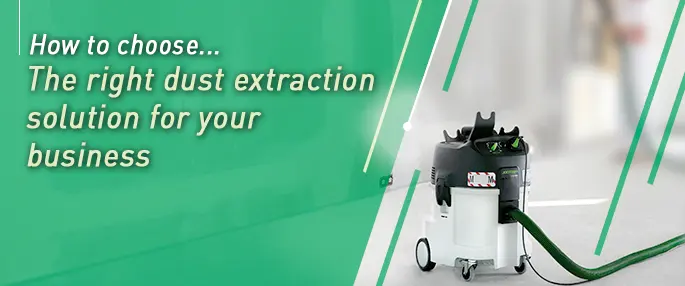[vc_row][vc_column][vc_column_text]
Your health and wellbeing at work is of paramount importance. Regularly breathing dust can cause diseases like lung cancer, asthma, chronic obstructive pulmonary disease and silicosis. In 2019, the Health and Safety Executive (HSE) estimated 18,000 annual new cases of self-reported breathing or lung problems were caused or made worse by the work environment, with around 12,000 lung disease deaths per year estimated to be linked to past exposures at work.
With the HSE making dust in the working environment a primary focus over recent years, issuing fines of up to £2000 where inefficient, the wrong or no dust extraction is being used, ensuring the right solution for the workplace is not only a legal requirement but a moral obligation.
But what are the different classes of dust extraction? What are the differences between them? And what dust extraction class is required for what environment?
Our experts have answered your questions to help you choose the right dust extractor.
There are 3 main dust extraction classes in the UK: L Class, M Class and H Class.
L Class < 1.0% Dusts with maximum allowable concentrations (MAC) < 1 mg/m³
M Class < 0.1% Dusts with maximum allowable concentrations (MAC) ≥ 0.1 mg/m³
H Class < 0.005% Dusts with maximum allowable concentrations (MAC) < 0.1 mg/m³
There’s also ATEX compliant extractors, but we’ll come on to that later.
So, what does this all mean? Read below…
L Class Extraction
L Class (or Low Hazard Materials) is awarded to entry level extractors and is suitable for use with less hazardous dusts such as those generated from soft woods and gypsum in plasterboard. The filter is capable of extracting 99% of particles so is not suited for use with more hazardous dusts such as those from sanding paint, fibreglass or hardwood.
Recommended for: Soft woods | Gypsum | Corian
DTC recommends:
[/vc_column_text][/vc_column][/vc_row][vc_row][vc_column width=”1/2″][vc_single_image image=”2039″ img_size=”medium” alignment=”right” onclick=”custom_link” link=”https://www.dtc-uk.com/festool-ctl-midi-dust-extractor.html”][/vc_column][vc_column width=”1/2″][vc_column_text]
Festool CTL MIDI Dust Extractor
[/vc_column_text][vc_column_text]Low weight and compact dimensions, the CTL MIDI is the ideal companion for assembly, installation and renovation work. The compact wet/dry extractor with 15L container volume is perfect for extracting small to medium volumes of dust and dirt.
- Extremely compact and lightweight, for simple transport
- Strong suction power thanks to compact high performance turbine and conical suction hose
- Integral automatic electronic switch-on/shut-off for extraction from electric power tools
[/vc_column_text][vc_single_image image=”2071″ img_size=”medium” alignment=”center” onclick=”custom_link” link=”https://www.dtc-uk.com/festool-ctl-midi-dust-extractor.html”][/vc_column][/vc_row][vc_row][vc_column][vc_empty_space height=”10px”][vc_column_text]
M Class Extraction
M Class (or Medium Hazard Materials) extractors are 99.9% efficient, meaning that only 0.1% of particles might not be captured through the filters. M Class is the UK legal minimum as specified by the HSE for certain industries. Dust extractors rated as M Class will not necessarily offer greater filtration or suction performance but are generally better suited to trade users and will come fitted with safety features such as an alarm to notify the user when the filter is becoming clogged.
Recommended for: GRP | Hardwood | Paint
DTC recommends:
[/vc_column_text][/vc_column][/vc_row][vc_row][vc_column width=”1/2″][vc_single_image image=”2041″ img_size=”medium” alignment=”right” onclick=”custom_link” link=”https://www.dtc-uk.com/rupes-pneumatic-mobile-dust-extractor.html”][/vc_column][vc_column width=”1/2″][vc_column_text]
Rupes S145EP Pneumatic Mobile Dust Extractor
[/vc_column_text][vc_column_text]A professional extraction solution suitable for a variety of workshop environments. Predisposed for connection with both pneumatic and electric tools, the handy mobile extractor from Rupes even has a self-cleaning of filters function.
- Automatic self-cleaning system with filter cartridges
- Manual or Automatic startup
- Includes a built-in service level indicator to show you when the dust extractor needs replacement of motor brushes
[/vc_column_text][vc_single_image image=”2071″ img_size=”medium” alignment=”center” onclick=”custom_link” link=”https://www.dtc-uk.com/rupes-pneumatic-mobile-dust-extractor.html”][/vc_column][/vc_row][vc_row][vc_column][vc_column_text]
H Class Extraction
H Class (or High Hazard Materials) extractors remove 99.995% of dust, releasing less than 0.005% of dust back into the air. H Class is currently the highest extraction solution available and is suitable for carcinogenic dusts, and dusts containing pathogens. H Class commonly offer superior suction and filtration figures, even down to the way the bag is removed from the machine to avoid particles from being released back into the air.
Recommended for: Asbestos | Mould | Lead | Copper | Cadnium
[/vc_column_text][vc_single_image image=”2035″ img_size=”medium” alignment=”center” onclick=”custom_link” link=”https://www.dtc-uk.com/abrasives/dust-extraction.html”][/vc_column][/vc_row][vc_row][vc_column][vc_column_text]
ATEX Compliant Extraction
With recent innovations in composite materials, new binding resins are being introduced, some of which have explosive characteristics, this has led to an increased demand for ATEX extractors. ATEX extractors are designed to handle potentially explosive dusts. Through the use of wet filters (and other methods), explosive dusts can be neutralised and removed safely.
Recommended for: Carbon Fibre | Aluminium | GFRP
DTC recommends:
[/vc_column_text][/vc_column][/vc_row][vc_row][vc_column width=”1/2″][vc_single_image image=”2040″ img_size=”medium” alignment=”right” onclick=”custom_link” link=”https://www.dtc-uk.com/rupes-mobile-atex-dust-extractor-kx-135.html”][/vc_column][vc_column width=”1/2″][vc_column_text]
Rupes Mobile ATEX Dust Extractor KX 135
[/vc_column_text][vc_column_text]This powerful Rupes Mobile Extractor is ideal for composite users who handle potentially explosive dust like Carbon Fibre.
- Designed for safe working in potentially explosive atmospheres up to zone 22 (ATEX 99/92/CE)
- Meets directive ATEX 94/9/CE
- Pneumatically powered motor
- Extraction provided via a Venturi system
[/vc_column_text][vc_single_image image=”2071″ img_size=”medium” alignment=”center” onclick=”custom_link” link=”https://www.dtc-uk.com/rupes-mobile-atex-dust-extractor-kx-135.html”][/vc_column][/vc_row][vc_row][vc_column][vc_column_text]
If you have any questions, or want to explore what options you have available, our industry experts are always on hand to help. Don’t hesitate to give us a call today on 023 8025 1100.
[/vc_column_text][/vc_column][/vc_row][vc_row][vc_column][vc_single_image image=”2037″ img_size=”full” alignment=”center” onclick=”custom_link” link=”https://www.dtc-uk.com/abrasives/dust-extraction.html”][/vc_column][/vc_row][vc_row][vc_column][vc_column_text]You might also be interested in:
- Dust Extraction Requirements In The Finishing Industries
- Maintaining Safety Standards Around Carbon Fibre Dust
- 10 Top Tips For Cutting Carbon Fibre
- Is Carbon Fibre the New Asbestos?
[/vc_column_text][/vc_column][/vc_row]

